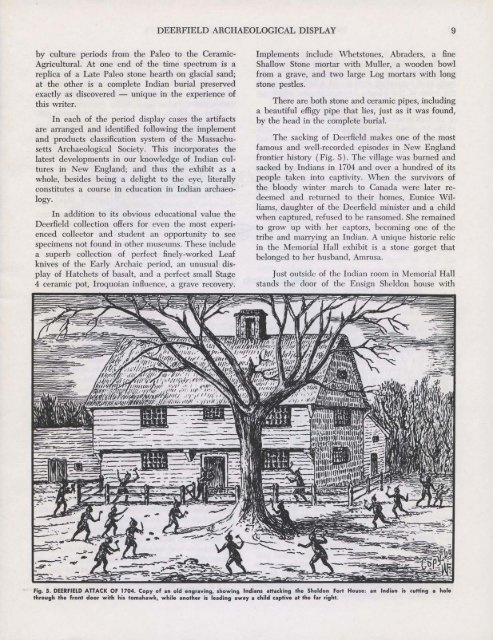The First Scientific Tool of Man, 31(3-4)
The First Scientific Tool of Man, 31(3-4)
The First Scientific Tool of Man, 31(3-4)
Create successful ePaper yourself
Turn your PDF publications into a flip-book with our unique Google optimized e-Paper software.
y culture periods from the Paleo to the Ceramic<br />
Agricultural. At one end <strong>of</strong> the time spectrum is a<br />
replica <strong>of</strong> a Late Paleo stone hearth on glacial sand;<br />
at the other is a complete Indian burial preserved<br />
exactly as discovered - unique in the experience <strong>of</strong><br />
this writer.<br />
In each <strong>of</strong> the period display cases the artifacts<br />
are arranged and identified following the implement<br />
and products classification system <strong>of</strong> the Massachusetts<br />
Archaeological Society. This incorporates the<br />
latest developments in our knowledge <strong>of</strong> Indian cultures<br />
in New England; and thus the exhibit as a<br />
whole, besides being a delight to the eye, literally<br />
constitutes a course in education in Indian archaeology.<br />
In addition to its obvious educational value the<br />
Deerfield collection <strong>of</strong>fers for even the most experienced<br />
collector and student an opportunity to see<br />
specimens not found in other museums. <strong>The</strong>se include<br />
a superb collection <strong>of</strong> perfect finely-worked Leaf<br />
knives <strong>of</strong> the Early Archaic period, an unusual display<br />
<strong>of</strong> Hatchets <strong>of</strong> basalt, and a perfect small Stage<br />
4 ceramic pot, Iroquoian influence, a grave recovery.<br />
DEERFIELD ARCHAEOLOGICAL DISPLAY 9<br />
Implements include Whetstones, Abraders, a fine<br />
Shallow Stone mortar with Muller, a wooden bowl<br />
from a grave, and two large Log mortars with long<br />
stone pestles.<br />
<strong>The</strong>re are both stone and ceramic pipes, including<br />
a beautiful effigy pipe that lies, just as it was found,<br />
by the head in the complete burial.<br />
<strong>The</strong> sacking <strong>of</strong> Deerfield makes one <strong>of</strong> the most<br />
famous and well-recorded episodes in New England<br />
frontier history (Fig. 5). <strong>The</strong> village was burned and<br />
sacked by Indians in 1704 and over a hundred <strong>of</strong> its<br />
people taken into captivity. When the survivors <strong>of</strong><br />
the bloody winter march to Canada were later redeemed<br />
and returned to their homes, Eunice Williams,<br />
daughter <strong>of</strong> the Deerfield minister and a child<br />
when captured, refused to be ransomed. She remained<br />
to grow up with her captors, becoming one <strong>of</strong> the<br />
tribe and marrying an Indian. A unique historic relic<br />
in the Memorial Hall exhibit is a stone gorget that<br />
belonged to her husband, Amrusa.<br />
Just outside <strong>of</strong> the Indian room in Memorial Hall<br />
stands the door <strong>of</strong> the Ensign Sheldon house with<br />
\<br />
Fig. s. DEERFIELD ATTACK OF 1704. Copy <strong>of</strong> an old engraving, showin9 Indians attacking the Sheldon Fort House: an Indian is cuHing a hole<br />
through the front door with his tomahawk, while another is leading away a child captive at the far right.
















